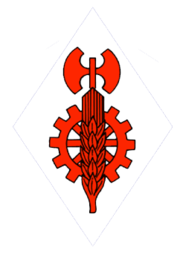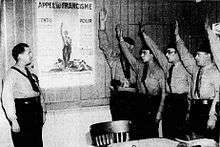Mouvement Franciste
The Francist Movement (French: Mouvement Franciste, MF) was a French Fascist and Antisemitic league created by Marcel Bucard in September 1933; it edited the newspaper Le Francisme. Mouvement Franciste reached of membership of 10,000, and was financed by Italian dictator Benito Mussolini. Its members were deemed the francistes or Chemises bleues (Blueshirts), and gave the Roman salute (a paramilitary character which was mirrored in France by François Coty's Solidarité Française).
Francist Movement Mouvement Franciste | |
|---|---|
 | |
| President | Marcel Bucard |
| Founded | 1933 |
| Banned | 1944 |
| Preceded by | Le Faisceau (Bucard was a member of Le Faisceau, many elements of the Mouvement originated from Le Faisceau) |
| Headquarters | Vichy, France |
| Newspaper | Le Francisme |
| Paramilitary wing | Blueshirts |
| Membership (1933) | 10,000 |
| Ideology | Francism |
| Political position | Far-right |
| Colours | Blue, red, gold |
| Party flag | |
 | |

The Mouvement took part in the violent Paris rallies of 6 February 1934, during which the entire far right (from Action Française to Croix-de-Feu) protested the implications of the Stavisky Affair and possibly attempted to topple the Édouard Daladier government. It incorporated the Solidarité Française after Coty's death later in the same year.
All the 6 February participant movements were outlawed in 1936, when Léon Blum's Popular Front government passed new legislation on the matter. After a failed attempt in 1938, the Movement was refounded as a Party (Parti Franciste) in 1941, after France was overrun by Nazi Germany.
Together with Jacques Doriot's Parti Populaire Français and Marcel Déat's Rassemblement National Populaire, the francistes were the main collaborators of the Nazi occupiers and Vichy France. The Parti Franciste did not survive the end of World War II, and was considered treasonous.
Creation
Francisme was created in August-September 1933 by Marcel Bucard, a former seminarian and war hero, who had already participated in a number of nationalist and proto-fascist movements: French Action, Faisceau, French Solidarity and Croix de Feu. The official creation takes place on 29 September 1933 at 11 pm, during a ceremony organized at the Arc de Triomphe in Paris. Marcel Bucard whilst delivering a speech at the ceremony states that he wants: "(...) to found a movement of revolutionary action whose aim is to conquer the power" and "to stop the race to the abyss".[1]
The movement was heavily inspired by Mussolini's National Fascist Party and so received significant funding and support from the Italian fascist movement. In response to this Bucard wrote, "Our Francism is to France what Fascism is to Italy".
Collaboration with the Germans
During the Occupation, the Franciste Movement was relaunched and along with Jacques Doriot's French Popular Party (PPF) and Marcel Déat's National Popular Rally (RNP) is one of the most notable political movement to collaborate with the occupying German authorities. . On May 5, 1941, Marcel Bucard and Paul Guiraud (associate of philosophy, son of Jean Guiraud, editor-in-chief of La Croix ) relaunched Francisme. Paul Guiraud attempted to give the movement a more "socialist" look. Similarly, Bucard defended the General Confederation of Labour (dissolved during the occupation) and criticized the Labor Charter elaborated by the Vichy regime, which he considered not socialist enough. Despite these attempts to appeal to the working class the movement still received the majority of its support from the far-right.[2]
The movement, like the other collaboration movements, failed to become a mass movement. At its peak (summer 1943), according to historian duo Lambert-Le Marec it had some 5,500 members (4,000 in the provinces and 1,500 in the Paris region) or according to other sources reach a maximum of 8,000 members.[3] The newspaper Le Franciste reached a maximum circulation during the war of 20,000 copies.
In 1943, it participated in a collaborationist front, dominated by the National Popular Rally, in an attempt to unify with other fascist movements. Like the other parties, the Franciste Movement was heavily collaborationist (creation of the Task Forces to fight against resistance was one such example). Many of its members participated in anti-Semitic and anti-communist operations as well as its members joining the Milice which actively targeted the French Resistance.[4] Particularly well established in the departments of Seine-et-Oise and Morbihan where locals were involved in incidents of rare violence.
On July 4, 1944, a policeman was killed and another injured by the bodyguards of Bucard during an altercation. Bucard is then imprisoned however released on July 29, just in time to flee to Germany on August 12 with the other Francists as the Allies launch Operation Overlord. Bucard was finally arrested, tried and sentenced to death on February 21, 1946, shot on March 19 at Fort Chatillon, near Paris. Facing the pole, he refused to wear a headband and once attached, shouted "Qui vive? La France!" before the salvo struck him dead. His family were denied a request that his body be deposited in the family vault and Marcel Bucard was buried in the Parisian cemetery of Thiais, in the current department of Val-de-Marne.
References
- https://www.abebooks.co.uk/book-search/title/bucard-francisme/author/alain-deniel/
- https://www.amazon.fr/collaborateurs-1940-1945-Pascal-Ory/dp/2020054272
- http://www.chire.fr/A-137943-vichy-1940-1944-organisation-et-mouvements.aspx
- https://www.cairn.info/revue-histoire-de-la-justice-2019-1-page-229.html
- John Bingham Defining French fascism, finding fascists in France Canadian Journal of History (Dec. 1994)
- Stanley Payne A history of fascism, London, University College of London Press, 1995, pp. 400-401.
